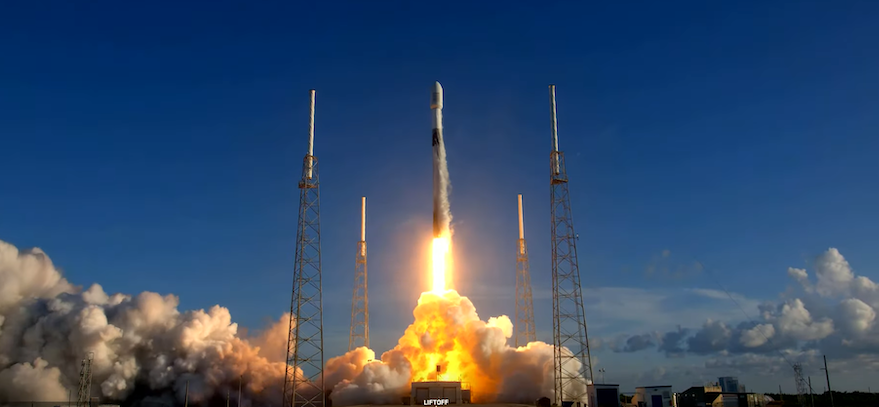SPACE RACE 2.0
South Korea’s first lunar orbiter on way to the moon

SEOUL, South Korea — South Korea’s first lunar orbiter has begun its voyage toward the moon on a mission critical to the country’s future space projects.
The 678-kilogram spacecraft, named Korea Pathfinder Lunar Orbiter (KPLO) or Danuri in Korean, launched on a SpaceX Falcon 9 rocket from Cape Canaveral Space Force Station’s Launch Complex 40 at 7:08 p.m. Eastern, Aug. 4.
The Danuri orbiter is carrying six scientific instruments, including a hypersensitive optical camera, ShadowCam, provided by NASA and a “space internet” demonstrator developed by South Korea’s Electronics and Telecommunications Research Institute, which will validate an interplanetary internet connection using delay-disruption tolerant networking.
The orbiter was working normally and traveling on a planned trajectory toward the moon, said the Korea Aerospace Research Institute (KARI), which controls the spacecraft. It is expected to enter the moon’s orbit in December before starting a year-long observation mission. If it succeeds, South Korea will become the world’s seventh lunar explorer, after the former Soviet Union, the U.S., China, India, the European Union and Japan.
The Falcon 9’s upper stage deployed its dedicated payload 40 minutes after liftoff. The rocket’s first stage made a pinpoint landing on the SpaceX droneship “Just Read the Instructions” nine minutes after liftoff. It was the sixth touchdown to date for the booster, SpaceX said.
The launch was scheduled for Aug. 2 but was delayed two days to allow time for SpaceX to complete additional work on the Falcon 9 rocket.
The orbiter, developed by KARI, unfurled its two solar panels shortly after the deployment and exchanged first signals with a NASA ground station in Canberra, Australia, about 45 minutes later, according to KARI. It will stay connected to the Earth around the clock through a network of four ground stations — Korea Deep Space Antenna in South Korea; NASA’s Canberra Deep Space Communication Complex in Australia; Madrid Deep Space Communications Complex in Spain; and Goldstone Deep Space Communications Complex in the United States.
South Korea President Yoon Suk-yeol hailed the successful launch, calling the spacecraft “pathfinder” that will give a boost to South Korea’s economy and scientific prowess. “Danuri has just begun its 130-day journey toward the moon,” Yoon wrote on Facebook. “I look forward to seeing images of the moon and BTS’s ‘Dynamite’ the Danuri will send (to Earth) at the end of the year. Go for it, Danuri!”
Dynamite is Korean pop star BTS’s mega-hit song, and the Korean orbiter will conduct a test of sending a file of its music video to the Earth from the lunar orbit in a “space internet” technology demonstration.
KPLO’s lunar trajectory
The KPLO is set to fly to the moon on a low-energy, fuel-efficient ballistic lunar transfer trajectory, a path being pioneered by NASA’s CAPSTONE cubesat, launched in late June on Rocket Lab’s Electron rocket from New Zealand.
The KPLO is currently on a trajectory that will take it close to the L1 Lagrange point, a gravitationally stable location nearly 1.5 million kilometers from the Earth and four times farther than the moon. Gravitational forces will naturally pull the orbiter back toward the Earth and the moon.
The Korean spacecraft — if everything goes as planned — will be captured in lunar orbit on Dec. 16, according to KARI. A series of propulsive maneuvers with the spacecraft’s thrusters will steer it into a circular, low-altitude orbit about 100 kilometers from the lunar surface by Dec. 31. After a brief period of commissioning and tests, the spacecraft’s yearlong mission is expected to begin in January.
Science objectives
With the six instruments aboard, the orbiter will collect a variety of data orbiting the moon twelve times a day. NASA’s ShadowCam will peer into permanently shadowed craters at the lunar poles in search of large quantities of ice that radar observations suggest is present. To see into the dark shadows and spot hidden ice, ShadowCam has been designed to be several hundred times more light-sensitive than any previous camera to have gone to the moon, according to NASA.
Collected data will be shared with NASA, which aims to send humans to the moon in the coming years under its Artemis program.
A South Korea-developed gamma-ray spectrometer called KGRS will look for any spontaneous gamma ray bursts produced by massive dying stars; a magnetometer called KMAG will track the magnetic field between Earth and the Moon; and a high-resolution camera LUTI will take high-resolution images of the lunar surface, which would be used for South Korea’s lunar landing mission targeted for the early 2030s.
The orbiter is also armed with PolCam, a wide-angle polarimetric camera that will study the bulk properties of the lunar surface material. The space internet test will be conducted by the Disruption Tolerant Network Experiment Payload (DTNPL).
South Korea began developing the KPLO mission in 2016 for a planned launch in 2020, but officials delayed the mission after the spacecraft grew above its original launch weight, and engineers needed more time to revise its design and other details. This project cost 236.7 billion won ($182 million).
No comments:
Post a Comment